“Is Bigger Best?” Report — Part 1: Limits to Scale in Wind
Full report available at ilsr.org.
Introduction: The Savings of Size?
For nearly a century, it’s been considered conventional wisdom that larger-scale power generation means lower-cost electricity. This wisdom is built on two basic theories of economies of scale.
Below is part one of our “Is Bigger Best?” report, a report released in September 2016. Conventional wisdom suggests the biggest wind and solar power plants will be cheapest, but where they deliver power, and who will own them, matters more. Be sure to read parts two and three in the next week.
First, there’s the simple fact that larger volume components of power plants provide more usable space than the related materials costs. This simple illustration explains. The box on the left has a volume of 1x1x1 = 1 cubic foot. To assemble the box, you need 6 square pieces of material, each with an area of 1, for a total of 6 square feet. The box on the right has a volume of 2x2x2 = 8 cubic feet. The larger box can be assembled of 6 square pieces, each with an area of 2×2 = 4 square feet, for a total of 24 square feet. We’ve increase the volume of our container 8-fold, with only a 4-fold increase in material costs.

As power plants became bigger in the first half of the 20th century, they captured this economy of scale in materials.
The second basic theory is that the average cost of a product decreases the more you make of it. This takes into account the scale economies in material costs (in building the factories), but also the notion that some overhead costs (such as annual registration fees, insurance, etc) are fixed or grow more slowly than the total output of a business.
Both of these theories were well supported by data in the early years of electricity generation in the 1900s, with coal, oil, and then nuclear power plants producing lower cost power from larger sized plants. The advantage to size also lent credence to the conventional wisdom of monopoly utilities. Big power plants required large amounts of capital, and capital markets offered lower interest rates to companies that did not have the risk of competition for their ever-larger power plants. Chip in a few dollars a month to help support independent cleantech coverage that helps to accelerate the cleantech revolution!
Chip in a few dollars a month to help support independent cleantech coverage that helps to accelerate the cleantech revolution!
But after decades of success, the “bigger-is-better” mantra stopped generating returns on investment, nearly 50 years ago. In super-large fossil fuel power plants, specialized equipment required excessively high temperatures and special materials that were more expensive than the marginal gains in efficiency. This graphic, from a book called Power Loss, illustrates the plateauing of power plant efficiency in the mid-1960s, as challenges in operating giant power plants offset their economies of scale.
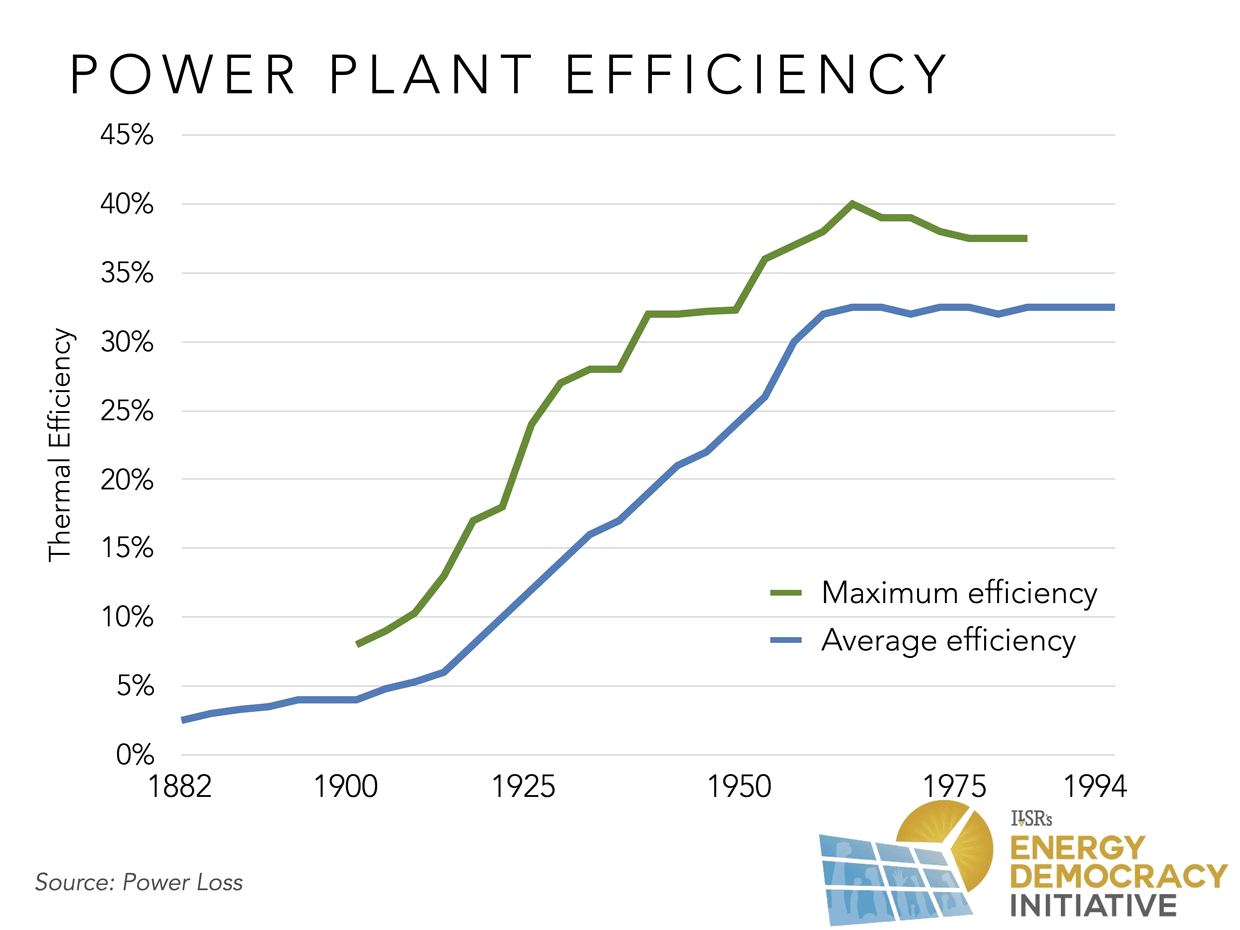
The plateau in plant efficiency from technical challenges was accompanied by a leveling off in the cost reductions of building bigger. Bigger power plants, evidence suggested, incurred higher indirect costs, such as much longer construction time. In the 1970s in particular, high inflation and other factors made up as much as 60% of a power plant’s cost, and made delay costly.
Despite the evidence about limits to scale economies, the conventional wisdom that bigger is better has persisted into the renewable energy power industry. It’s particularly ironic, since the costly ever-bigger power plants of the 1970s led Congress to pass the 1978 Public Utility Regulatory Policies Act (PURPA), the federal law that opened the door to renewable energy alternatives to conventional power plants. This lesson seems lost on many observers of the renewable energy industry.
Renewable Energy Economies of Scale
The economies of scale of renewable energy take three forms, slightly different than those for fossil fuels:
- The first is similar, that larger solar or wind power plants will produce less costly power than smaller ones, given a similar level of sunshine or wind.
- The second suggests that renewable electricity is best produced in areas of the highest resource quality, and then transmitted long-distance to users.
- The third is an assertion that the road to the most renewable energy the most quickly is via the largest power plants.
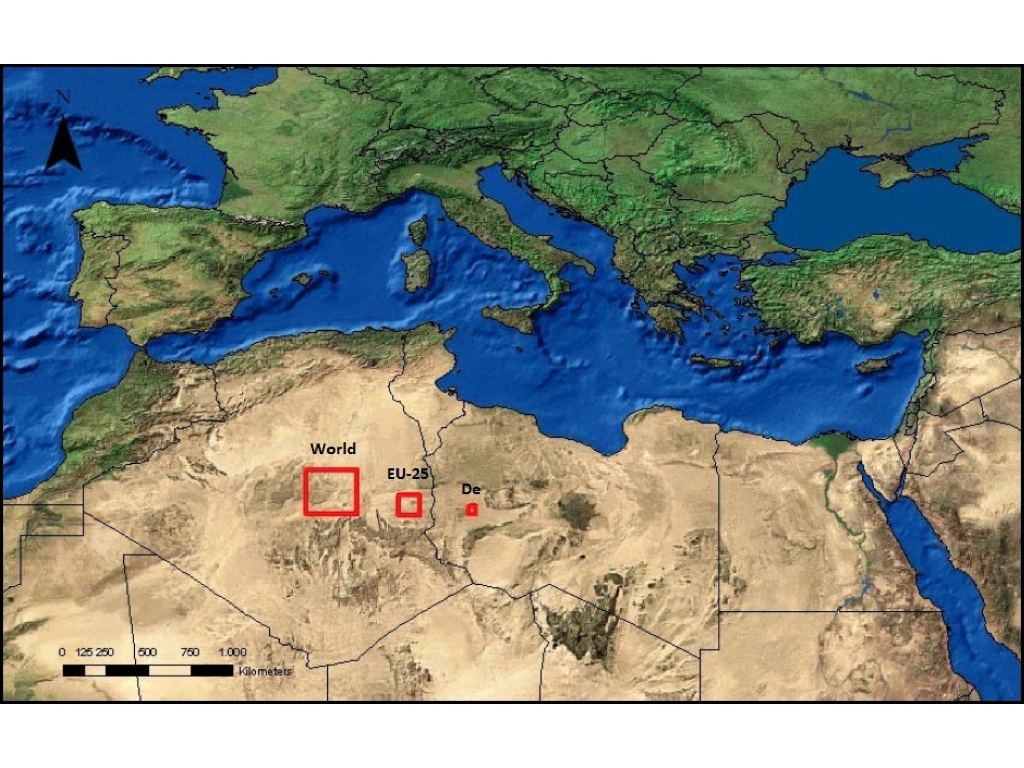 In 2008, New York Times reporter Matthew Wald hit all three of these assumptions. He suggested that the major barrier to expanding the nation’s wind power was lack of transmission capacity. To tap the country’s wind resources required building vast wind power projects in the windy Midwest and then shipping that power to population centers on the coasts, argued Wald (and others).
In 2008, New York Times reporter Matthew Wald hit all three of these assumptions. He suggested that the major barrier to expanding the nation’s wind power was lack of transmission capacity. To tap the country’s wind resources required building vast wind power projects in the windy Midwest and then shipping that power to population centers on the coasts, argued Wald (and others).
In the same article, Wald described “immense solar-power stations in the nation’s deserts,” a reference to concentrating solar thermal power plants that focus sunlight with hundreds of mirrors to generate heat, then steam, then electricity. Like Wald, many observers thought that the quickest way to mass deployment of solar energy was building out many of these multi-hundred-megawatt facilities in the world’s deserts, then shipping that electricity via new transmission lines back to population centers. One initiative, called Desertec, even proposed to power all of Europe with concentrating solar thermal power plants in the North African desert. The adjacent image was circulated widely at the time, with the red squares representing the areas that could be covered with reflective mirrors to generate enough electricity to power the entire world, the EU25, or Germany.
The arguments over scale have continued. Investor-owned utility Xcel Energy released a video in 2015 decrying “thinking small” in favor of “large scale solar projects that deliver energy more economically.” Just last year, a Brattle Group study suggested that utility-scale solar power plants were much less costly than distributed ones. These are just two shots fired in a larger battle over the size and scale of renewable energy deployment.
Evidence to the Contrary
The managers of electric utilities eventually realized there were limits to scale economies of fossil fuel power plants, in part because smaller-scale cogeneration and renewable energy power plants allowed under PURPA undercut the utility’s electricity costs. In renewable energy, the main issue is whether large, custom-built wind and solar projects can compete with small, mass-produced ones, when the former require access to big, expensive infrastructure that the latter do not.
Limits to Scale in Wind
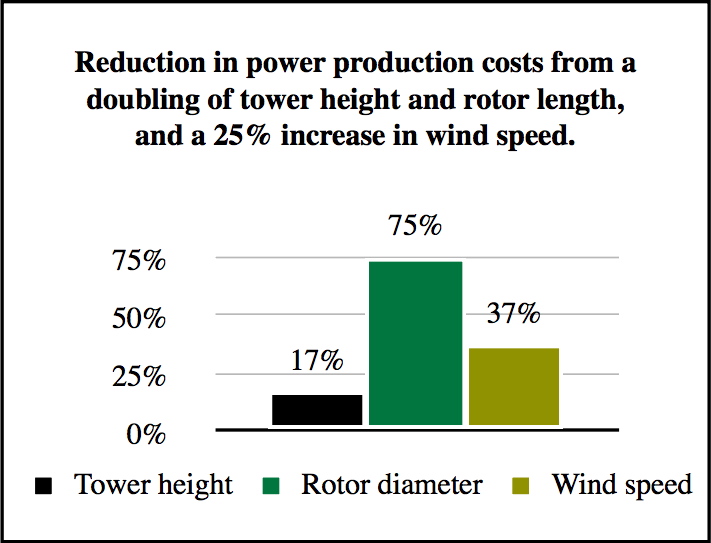 To address the economies of scale question for wind power, we have to address the scale economies of a single turbine, a group of turbines (called a wind farm or wind project), and whether it’s better to chase the best resource or build (at smaller scale) close to demand.
To address the economies of scale question for wind power, we have to address the scale economies of a single turbine, a group of turbines (called a wind farm or wind project), and whether it’s better to chase the best resource or build (at smaller scale) close to demand.
On the question of the single turbine, there are several ways to get more electricity out of a single wind turbine:
- Make it taller
- Make the blades longer
- Put it in a windier place
In a 2007 report, ILSR detailed the significant benefits of these changes (shown in the graphic to the right). Doubling the height of a wind turbine can reduce the cost of electricity it produces by 17%; doubling the size of the rotors can do even more, reducing the power cost by 75%. Although average turbine height seems to have leveled off near 80 meters, there’s little sign the the scale economies of a single turbine have reached their limits. Data from the 2015 Wind Technologies Market Report shows a steady increase rotor length and rated capacity, allowing individual wind turbines to produce more electricity.
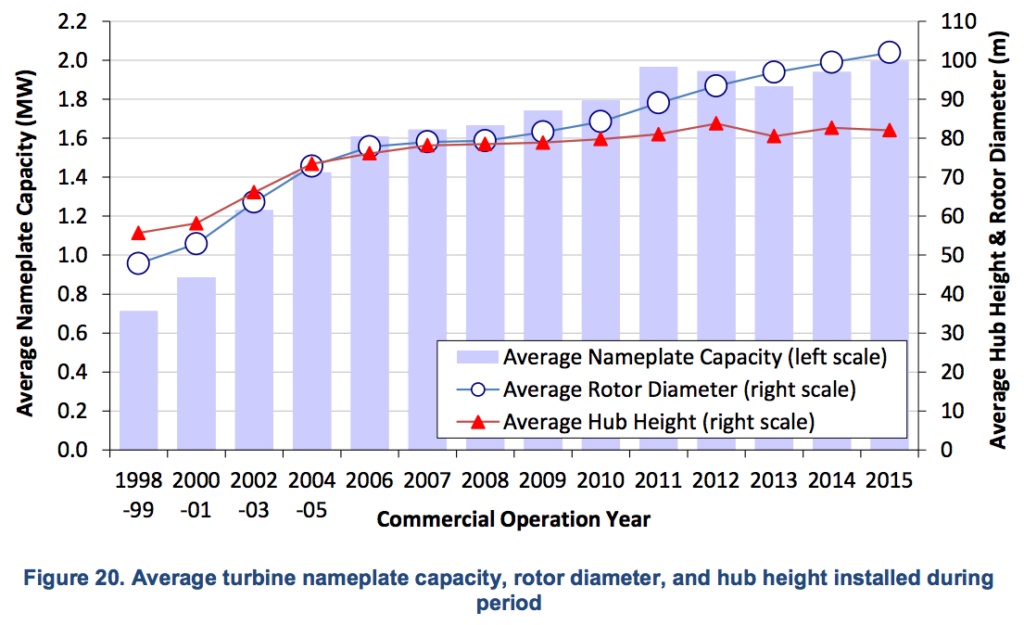
In other words, there are clear economies of scale in the size of a single wind turbine.
Given these scale economies, the next question is whether large wind farms or smaller ones make economic sense. Based on data released in 2010, the conventional wisdom seemed shattered. Wind projects installed in 2007-09 actually exhibited dis-economies of scale, with larger projects costing more than projects sized between 5 and 20 megawatts (using 3 to 12 average-sized turbines).
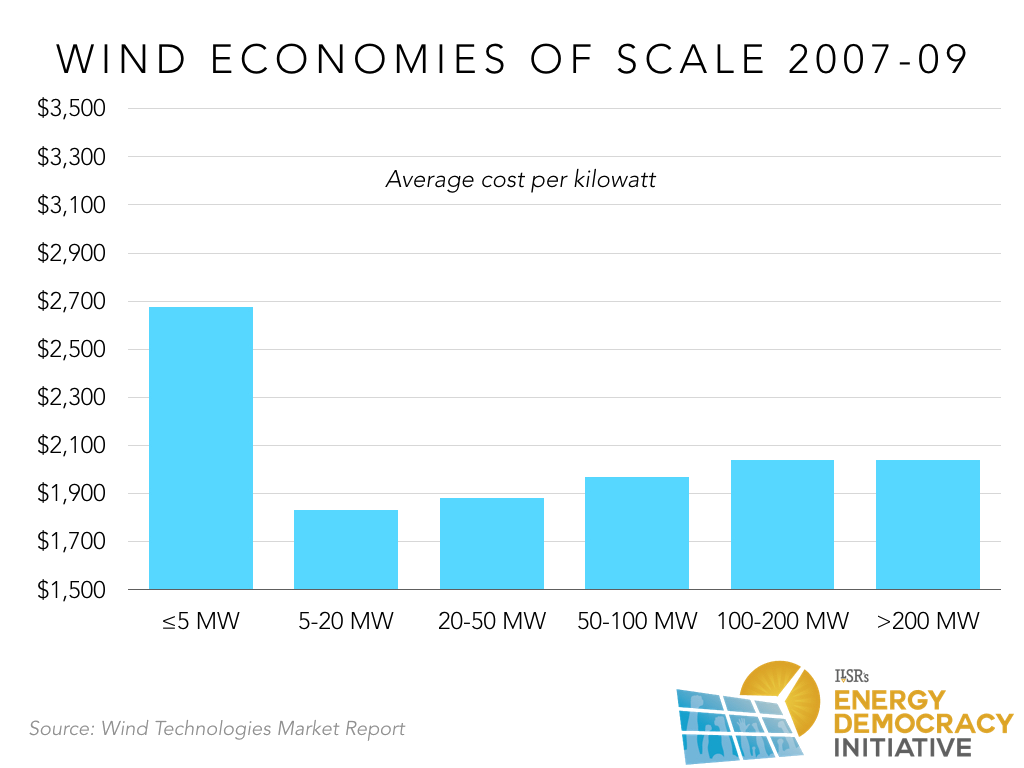
The 2010 data seems to be an aberration, as subsequent data aligns with the conventional wisdom of scale economies. One potential difference is that many regional transmission operators adopted cost-sharing provisions around 2010-11 that lifted the burden of transmission expansion from individual project developers and allowed it to be shared among all electric customers in the region. Since larger projects would have been more likely to incur transmission upgrades, it may explain at least part of the higher costs for larger projects.
The following chart shows the recent economies of scale data for wind farms by size, highlighting 2011 and 2015 data. It’s clear that scale economies have increased substantially at the breakpoint of 5 megawatts, with the smallest projects nearly double the per-kilowatt cost of ones 5 megawatts and larger.
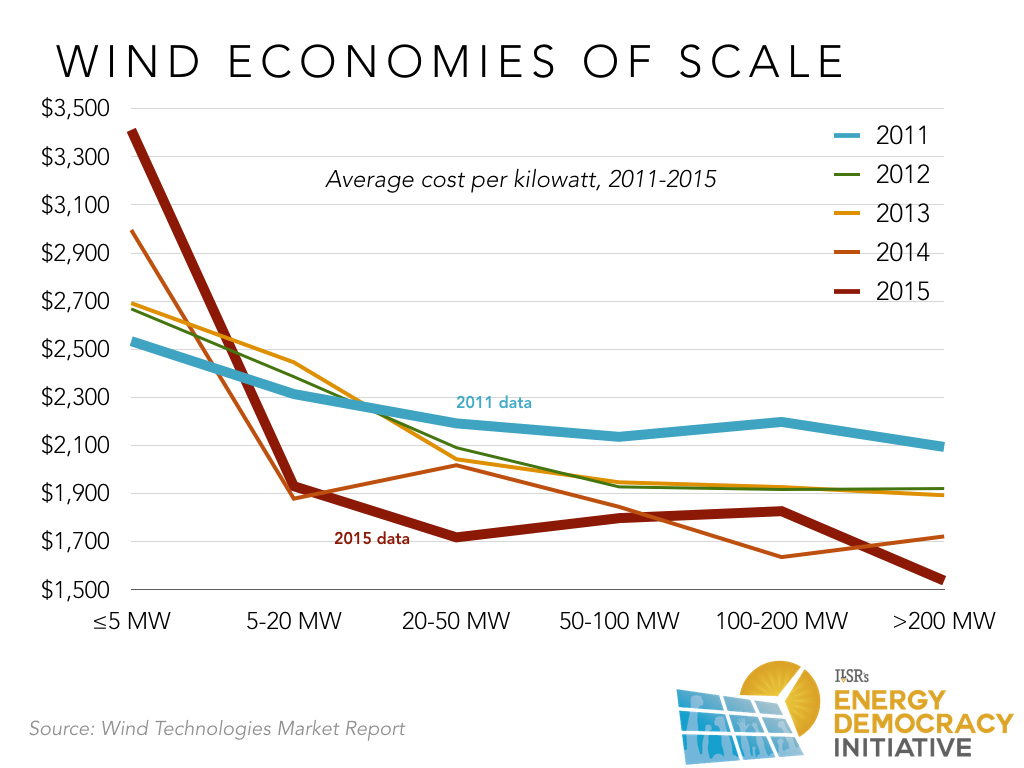
Although the five lines above show the gradual increase in economies of scale of larger wind farms, combining the lines into a five-year average is also instructive. The chart below shows the cost per kilowatt for wind farms of increasing size as a percentage of projects sized 5 to 20 megawatts. The lesson is that two-thirds of the economies of scale of wind farms is captured when projects exceed 5 megawatts of total capacity.
 There are two caveats about data showing lower prices for larger projects: the price of competition and the cost of transmission.
There are two caveats about data showing lower prices for larger projects: the price of competition and the cost of transmission.
While nearly all commercial scale wind projects sell electricity into the grid, the smallest projects may be competing against a different price than the larger ones. There’s some evidence from community-scale developers that the fair contract price for electricity for projects under 5 megawatts that connect near utility substations (receiving the “avoided cost” utilities are required to pay under PURPA) may be much higher than grid wholesale prices because it avoids both generation and transmission costs.1 The following chart (converting the costs per kilowatt above into a 20-year price of electricity) illustrates how this avoided cost is much higher than the wholesale market price, sometimes called the “day-ahead locational marginal price.” It means that even the smallest wind power projects can be cost-effective.

This value advantage of small projects may be an opening for community-based wind projects that have previously been seen as uneconomical in comparison to large-scale ones. However, “community shared wind” has yet to enjoy the popularity of community shared solar, as noted in ILSR’s 2016 report.
The second caveat about the advantages of scale is the issue of costs to transmit power to customers. All of the costs shown in the above charts include interconnection to the electric grid, but may not include costs to upgrade the transmission system to accommodate the new capacity. Larger projects are more likely to incur these system upgrade costs, which are typically spread among all electric customers. Therefore, it’s hard to disaggregate transmission costs and get an accurate picture of whether the largest wind projects are truly the most economical.
So individual turbines show clear economies of scale, but with wind projects the data is less clear.
In the third economies of scale issue, of wind farm size and distance from the best wind resources, the data is also muddled. The windiest and most remote sites likely have the greatest amount of space for new wind projects, whereas projects sited close to consumers may have to be smaller. In ILSR’s 2007 report on wind economies of scale, we examined this issue and concluded that the cost of transmission can consume the advantage of building larger in a better wind resource. The following table provides some illustrations, with values in green showing wind speed increases that can offset transmission costs, and red values showing where the cost to transmit outweigh wind resource benefits (assuming a similarly sized wind power project).
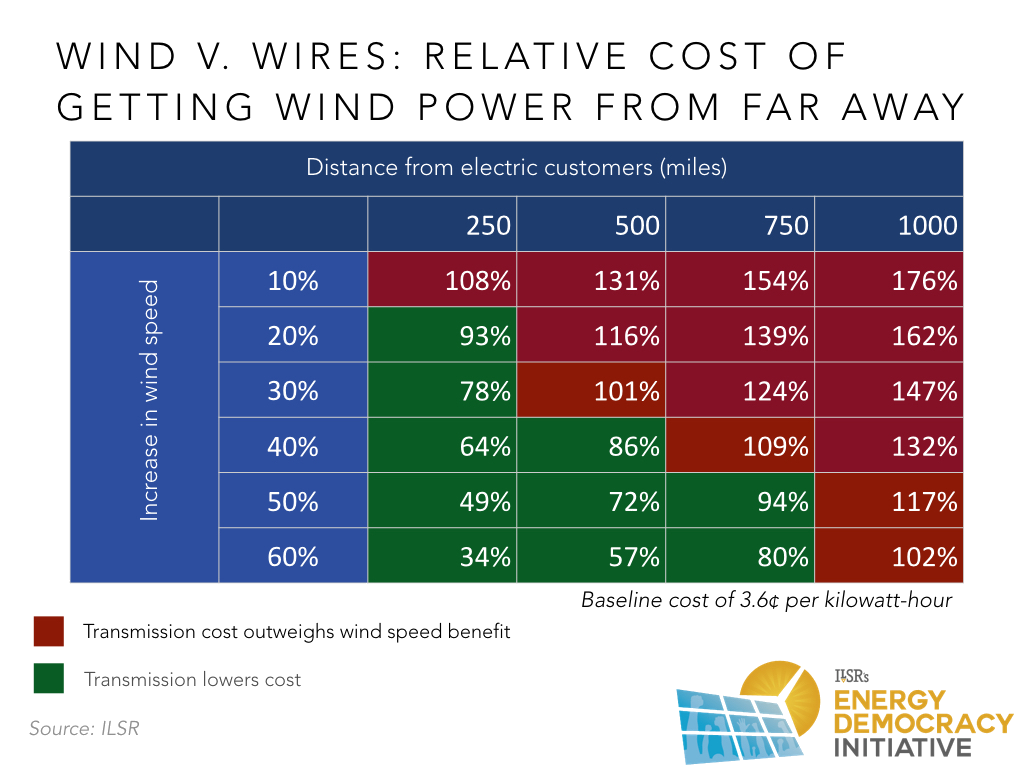
To get a sense of how these calculations play out in the real world, the following map shows that many large cities could benefit from getting electricity from wind farms within 400 miles, but that longer distances cannibalize the savings of higher wind speeds. For this map, we assumed that projects proximate to the city would be smaller (between 100 and 200 megawatts) and produce electricity that was more costly by about 3.5%.

The issue of transmission infrastructure is complicated by the fact that transmission planning tends to lack transparency and access for local communities, and a serious consideration of alternatives.
While the largest wind power projects may have a marginal price advantage, it’s also true that big wind farms, unlike smaller ones, aren’t compatible with ownership structures that deliver greater economic benefits to the local community. Since sub-5-megawatt wind projects may be able to compete at a different price point, having community ownership may prove more economically lucrative (even with a slightly higher electricity price) than purchasing power from a remote wind farm.
There’s a clear economy of scale in the size of individual wind turbines and the construction of wind farms. However, the issue of energy transmission complicates the analysis. Given the process and cost-sharing elements of transmission planning, it’s difficult to disaggregate these effects. There may also be benefits to the smallest wind (and solar) projects being able to access higher contract prices that may make these community-scale projects more competitive.
Full report available at ilsr.org. For timely updates, follow John Farrell on Twitter or get the Energy Democracy weekly update.
Have a tip for CleanTechnica? Want to advertise? Want to suggest a guest for our CleanTech Talk podcast? Contact us here.
Latest CleanTechnica.TV Video

CleanTechnica uses affiliate links. See our policy here.
